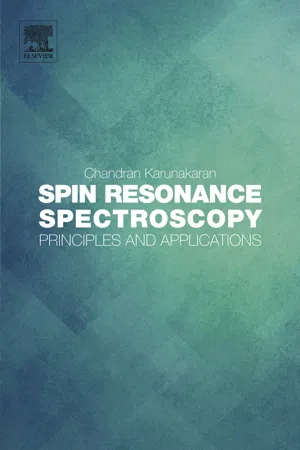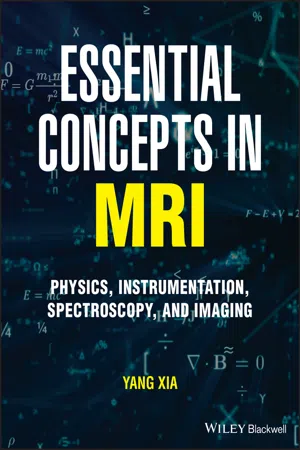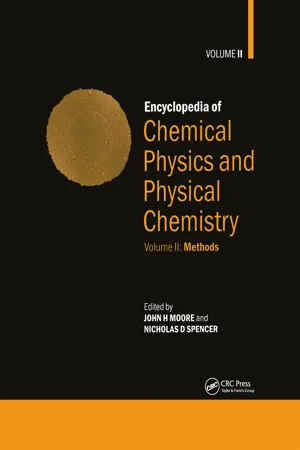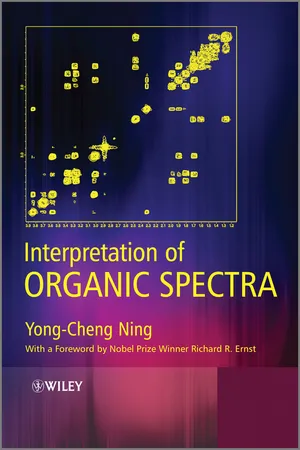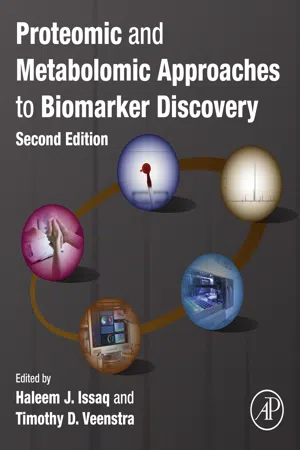Chemistry
Hydrogen -1 NMR
Hydrogen-1 NMR, also known as proton NMR, is a technique used to study the chemical environment of hydrogen atoms in a molecule. It relies on the magnetic properties of hydrogen nuclei and their interaction with an external magnetic field. By analyzing the resulting NMR spectrum, valuable information about the structure, connectivity, and dynamics of molecules can be obtained.
Written by Perlego with AI-assistance
Related key terms
Related key terms
1 of 4
Related key terms
1 of 3
9 Key excerpts on "Hydrogen -1 NMR"
- eBook - ePub
Spin Resonance Spectroscopy
Principles and applications
- Chandran Karunakaran(Author)
- 2018(Publication Date)
- Elsevier(Publisher)
1 H Nuclear Magnetic Resonance2.1.1. What Can Be Obtained From a 1 H Nuclear Magnetic Resonance Spectrum?
Analysis and interpretation of nuclear magnetic resonance (NMR) spectrum provided the following useful informations to understand the structure of a molecule and compound [1 –3 ].1. The number of peaks (in low-resolution NMR without spin–spin splitting) tells us about how many different kinds or types of proton present in the molecule. 2. The chemical shift values, i.e., the positions of the peaks tell us about the electronic environment of each kind of proton and the functional group. 3. The relative intensities of the peaks (or area of the peaks) tell us about the number of protons of each kind, which are present. The area of the peak is obtained by integration.4. The spin–spin splitting of a peak into several peaks (in high-resolution NMR) identifies the environment of a proton with respect to other nearby protons in the molecule. In other words, it tells us about adjacent functional groups and therefore connectivity.For example, CH3 protons connected to CH2 protons show triplet signal.2.2. Assignment of 1 H Nuclear Magnetic Resonance
The different positions of NMR absorptions are described as chemical shifts (δ). A chemical shift is defined as the difference in parts per million (ppm) between the resonance frequency of the observed proton and that of the tetramethylsilane (TMS) hydrogens. TMS is the most common reference compound used in NMR. It is set at δ = 0 ppm.Chemical shift , ppm δ =( Frequency of signal − frequency of reference )×10 6Spectrometer frequency( in Hz )The assignment of chemical shift values of each peak to protons in the functional group of molecules is given in Table 2.1 .The proton chemical shifts exhibit a range from − 20 (for metal hydrides viz ., [H-Rh(CN)5 ]3- ) to 40 ppm (for naked protons). But the majority of the organic compounds appear in the range 0–10 - eBook - ePub
- David G. Watson(Author)
- 2020(Publication Date)
- Elsevier(Publisher)
8: Nuclear magnetic resonance spectroscopy
- Introduction,
- Instrumentation,
-
Proton (1 H) NMR,
- Chemical shifts,
- Integration and equivalence,
- Multiplicity and spin–spin coupling,
- Splitting diagrams and spin systems,
-
Application of NMR to structure confirmation in some drug molecules,
- Proton NMR spectrum of paracetamol,
- Proton NMR spectrum of aspirin,
- Proton NMR spectrum of salbutamol: a more complex example,
-
Carbon NMR,
- Chemical shifts,
-
An example of a 13 C spectrum,
-
Two-dimensional NMR spectra,
- Simple examples,
- A more complex example,
- Application of NMR to quantitative analysis,
-
Other specialized applications of NMR,
- NMR in drug metabolism and related areas,
- Applications of NMR in the pharmacopoeias,
KeypointsPrinciplesRadiation in the radiofrequency region is used to excite most commonly protons or carbon-13 atoms, so that their spins switch from being aligned with to being aligned against an applied magnetic field. The range of frequencies required for excitation and the complex splitting patterns produced are very characteristic of the chemical structure of the molecule. - eBook - ePub
Essential Concepts in MRI
Physics, Instrumentation, Spectroscopy and Imaging
- Yang Xia(Author)
- 2022(Publication Date)
- Wiley-Blackwell(Publisher)
Part I Essential Concepts in NMRPassage contains an image
2 Classical Description of Magnetic Resonance
2.1 FUNDAMENTAL ASSUMPTIONS
The states of atomic nuclei are quantum mechanical by nature. This means that the properties that we observe for a single nucleus belong to one in a discrete set of possibilities (i.e., quantum states). A deep understanding of NMR phenomenon therefore requires the assistance of quantum mechanics. In practical NMR and MRI experiments, however, we deal with an extremely large number of nuclei in any specimen (either a human or a tissue block or a drop of liquid). For example, if I give you a glass container that has 18.015 grams of liquid water, do you know how many water molecules are in the container? Well, we know precisely how many are in it: 6.022 × 1023 water molecules (Avogadro’s number, since one mole of water is 18.015 grams)! Consider taking just one gram of water from the container, which has a volume of one milliliter. If this one milliliter of water is further divided into 100 droplets, each tiny droplet still contains about 3.343 × 1020 water molecules, or about 6.686 × 1020 protons (i.e., hydrogen atoms) since each water molecule has two hydrogen atoms. It is an enormous number.It is fortunate that these protons in a small water droplet act largely independently, so that at the macroscopic level, the collection of these protons appears continuous. (If these protons were to act completely independently, NMR would not have much practical use at all. If, on the other hand, these protons were to couple or interact tightly with each other, NMR also would not have much practical usage since we simply do not know how to solve the complex interactions among the enormous number of particles in any practical system.)The simplest and most common nuclei used in NMR and MRI are hydrogen, or protons, a component of the water molecules in the liquid state. Since a proton is a spin-1/2 particle (another quantum mechanical concept) and often very mobile, we could ignore internuclear dipole interactions and scalar coupling between the protons. Hence all states of the nuclear ensemble may be characterized by a vector quantity that is referred to as the nuclear magnetization (M - eBook - ePub
Encyclopedia of Chemical Physics and Physical Chemistry
Volume 2: Methods
- John H. Moore, Nicholas D. Spencer, John H. Moore, Nicholas D. Spencer(Authors)
- 2023(Publication Date)
- CRC Press(Publisher)
NMR of liquids Oliver W HowarthB1.11.1 Introduction
Nuclear magnetic resonance (NMR) was discovered by Bloch, Purcell and Pound in 1945, as a development of the use of nuclear spins in low-temperature physics. Its initial use was for the accurate measurement of nuclear magnetic moments. However, increases in instrumental precision led to the detection of chemical shifts (B1.11.5) and then of spin-spin couplings (B1.11.6). This stimulated use by chemists. There have been spectacular improvements in sensitivity, resolution and computer control since then, so that NMR equipment is now essential in any laboratory for synthetic chemistry. Within moments or hours, it can determine the structure and, if desired, conformation of most medium-sized molecules in the solution phase. For this reason, a large pharmaceutical company will typically generate several hundred NMR spectra in one working day. NMR is also widely used in biochemistry for the much more challenging problem of determining the structures of smaller proteins and other biomolecules. The rates and extents of molecular motions can also be measured, through measuring the rates of energy transfer to, from and between nuclei (relaxation, B1.13). Outside of chemistry, it is used in a different mode for medical and other imaging, and for the detection of flow and diffusion in liquids (B1.14). It can also be used for clinical and in vivo studies, as the energies involved present no physiological dangers.B1.11.2 Nuclear spins
NMR depends on manipulating the collective motions of nuclear spins, held in a magnetic field. As with every rotatable body in nature, every nucleus has a spin quantum number I. If I = 0 (e.g. 12 C, 16 O) then the nucleus is magnetically inactive, and hence ‘invisible’. If, as with most nuclei, I > 0, then the nucleus must possess a magnetic moment, because of its charge in combination with its angular momentumh. This makes it detectable by NMR. The most easily detected nuclei are those withI ( I + 1 )I =and with large magnetic moments, e.g. 1 H, 13 C, 19 F, 31 P. These have two allowed states in a magnetic (induction) field B0 : m1/2 and with angular momentum components mω1/2 . Thus these nuclear magnets lie at angles1 2±to B0 . They also precess rapidly, like all gyroscopes, at a rate υL . This is called the Larmor frequency, after its discoverer. The 2I + 1 permitted angles for other values of Icos− 1=( (1 2) / (3 4) )1 / 254.7 ∘ - eBook - ePub
- Yong-Cheng Ning(Author)
- 2011(Publication Date)
- Wiley(Publisher)
Chapter 1Interpretation of 1 H NMR SpectraAs described in the preface to this book, the NMR is the most important method to identify the structure of an unknown organic compound, because the information obtained from (one dimensional and two dimensional) NMR spectra is more abundant and interpretable than that obtained by other spectroscopic methods. Since NMR spectra have higher sensibility than other NMR spectra, NMR spectra can be acquired more easily in some ways, and we present NMR spectra in the first chapter of this book.Because the NMR spectrum can be interpreted in detail, it is possible to deduce the structure of an unknown compound, whose structure is not complex, only by using its NMR spectrum, NMR spectrum and the information about its molecular weight (without two dimensional NMR spectra). When we need to select the most reasonable structure from several possible structures, the NMR spectrum of that compound can play a very important role.Even when two dimensional NMR spectra were applied, the information, especially that from the analysis of coupled splittings in the NMR spectrum, would still be useful to deduce an unknown structure.The main parameters of NMR spectra are chemical shifts, coupled constants (and splitting patterns) and peak areas. If we consider a NMR spectrum from the viewpoint of physics, there is a fourth parameter, that is, relaxation times. However, relaxation times are short for NMR spectroscopy. Therefore, the variation of relaxation times does not produce variations of peak areas of NMR spectra. And relaxation times do not affect the interpretation of NMR spectra.The abscissa of the NMR spectrum is the chemical shift δ, which characterizes the position in a NMR spectrum of the peak of a functional group.Because of coupling interactions between magnetic nuclei, peaks in the - eBook - ePub
Understanding Advanced Organic and Analytical Chemistry
The Learner's ApproachRevised Edition
- Kim Seng Chan, Jeanne Tan;;;(Authors)
- 2016(Publication Date)
- WS EDUCATION(Publisher)
b protons are bonded to is tetrahedral in shape, and there is also free rotation about the C–C single bond.Fig. 17.1. Schematic of an NMR spectrometer.Two signals will appear in the 1 H NMR spectrum of bromoethane, each signal corresponding to one set of chemically equivalent protons. The Hb atoms are more shielded/less deshielded (experience weaker net magnetic field strength, have smaller energy gap, hence need stronger external applied magnetic field strength) than the Ha atoms. When a field sweep is carried out at increasing external magnetic field strength, the Ha atoms will resonate (spin-flip) first at lower field strength followed by the Hb atoms at a higher field strength.If a radio frequency sweep is conducted, the sample is placed under a constant external magnetic field strength while the magnitude of the radio frequency is varied. The Ha atoms, being less shielded/more deshielded (experience greater net magnetic field strength, have greater energy gap, hence require greater magnitude of radio frequency) than the Hb atoms, will resonate and give an absorption peak at a higher frequency.17.3.1 Chemical Shifts
In practice, the NMR absorption spectrum is neither plotted against magnetic field strength nor radiation frequency as the differences between absorption peaks are too small. This makes it hard to distinguish one peak from the other and hence the type of protons responsible for them. Furthermore, with the shielding or deshielding effect coming into play, it is better to have some sort of reference point from which useful data can be studied and compiled into a database. A common reference or internal standard used is tetramethylsilane (TMS), (CH3 )4 - eBook - ePub
- S. A. Richards, J. C. Hollerton(Authors)
- 2022(Publication Date)
- Wiley(Publisher)
9 Carbon-13 NMR Spectroscopy9.1 General Principles and 1-D 13 C
13 C NMR gives us another vast area of opportunity for structural elucidation and is incredibly useful in many cases where compounds contain relatively few protons, or where those that are available are not particularly diagnostic with respect to the proposed structures. Before we delve into any detail, there are certain general observations which we need to make regarding 13 C NMR and the fundamental differences that exist between it, and 1H NMR.For a start, we must be mindful of the fact that 13 C is only present as 1.1% of the total carbon content of any organic compound. This, in combination with an inherently less sensitive nucleus, means that signal-to-noise issues will always be a major consideration in the acquisition of 13 C spectra – particularly 1-D 13 C spectra which we will restrict the discussion to for the moment. (Note that the overall sensitivity of 13 C, probe issues aside, is only about 0.28% that of proton because the nucleus resonates at a far lower frequency – in a 400 MHz instrument, 13 C nuclei resonate at around 100 MHz.) So it takes a great deal longer to acquire 13 C spectra than it does proton spectra. More material is obviously an advantage but can in no way make up for a 350-fold inherent signal-to-noise deficiency!Another important aspect of 13 C NMR is that the signals are never normally integrated. The reason for this is that some carbon signals have quite long relaxation times. In order to make NMR signals quantitative, acquisition must allow for a relaxation delay (delay period between acquisition pulses) of at least five times the duration of the slowest relaxing nuclei in the compound being considered. With relaxation times of the order of 10–20 seconds, it is therefore obvious why we cannot obtain quantitative 13 C data. The inherent insensitivity of the 13 C nucleus often demands thousands of scans to achieve acceptable signal/noise so we can ill afford 100 second relaxation delays between pulses! The only thing that we can say is that methine, methylene and methyl carbons generally - Haleem J. Issaq, Timothy D. Veenstra(Authors)
- 2019(Publication Date)
- Academic Press(Publisher)
Chapter 7Current NMR strategies for biomarker discovery
Que N. Van Laboratory of Proteomics and Analytical Technologies, Advanced Technology Program, SAIC-Frederick, Inc., Frederick National Laboratory for Cancer Research, Frederick, MD, United StatesAbstract
The viability of nuclear magnetic resonance (NMR) spectroscopy as a tool for biomarker discovery has increased over the years as improvements in instrumentation that address NMR's inherent low sensitivity and bioinformatics resources for NMR data handling and analysis have matured. In this chapter, current NMR strategies for metabolic profiling are surveyed. The main focus is analysis of small molecules in biological samples using high-resolution liquid-state techniques. Analysis of cell and tissue via ex vivo and in vivo methods is also discussed. The methodologies covered include one- and two-dimensional experiments, as well as sample preparation and data treatment for statistical analysis.Keywords
Nuclear magnetic resonance spectroscopy; NMR; MRS; HR-MAS; Biomarker; Metabolomics; Metabolic profiling; BiofluidsOutline- Introduction: Why NMR?
- Advancements in NMR hardware
- Sample preparation for NMR analysis
- Biological fluids without macromolecules
- Biological fluids with macromolecules
- Cells and tissue extracts
- Intact tissue for HR-MAS
- Internal and external chemical shift standards
- One-dimensional NMR methods: 1 H, 13 C, 31 P
- 1 H
- 13 C
- 31 P
- 2D methods
- Homonuclear 2D
- Heteronuclear 2D: 1 H-13 C HSQC
- Targeted metabolic profiling
- Targeted analysis: Stable isotope tagging
- Targeted analysis: Metabolite specific
- Flux analysis using 13 C labeling
- High-resolution magic angle spinning (HR-MAS) NMR spectroscopy
- Magnetic resonance spectroscopy (MRS)
- NMR data processing and preparation for statistical analysis
- Data postprocessing
- Spectral alignment
- Nelu Grinberg, Sonia Rodriguez, Nelu Grinberg, Sonia Rodriguez(Authors)
- 2019(Publication Date)
- CRC Press(Publisher)
The goal of this section is to introduce the reader to analytical techniques that enable the characterization and study of molecular structure using NMR spectroscopy. In particular the application of modern NMR spectroscopic techniques to the structural elucidation of small organic molecules will be covered. The practical aspects of key NMR experiments will be explored. Topics covered will include the homonuclear and heteronuclear correlation experiments, and use of integration, chemical shift, and coupling constants in a structural example. Analysis of basic and complex molecules with overlapping signals will be discussed.For most structure elucidation problems encountered in organic chemistry there are seven basic experiments commonly applied. These include one-dimensional proton and one-dimensional carbon-13 experiments. In addition, two-dimensional heteronuclear 1 H,1 H COSY, 1 H,1 H TOCSY, I H,I H NOESY, or I H,l H ROESY, and heteronuclear 1 H,13 C HSQC, 1 H,13 C HMQC, and 1 H,13 C HMBC experiments are required.For NMR structural characterization, 2D homonuclear correlation experiments that connect signals through chemical bonds include correlation spectroscopy (COSY) [45 ] and total correlation spectroscopy (TOCSY) [46 ]. The two-dimensional spectra are typically displayed as a 2D contour plot.In the COSY spectrum the 1D proton spectrum is traced on the diagonal of the plot. Peaks that are not on the diagonal are correlation peaks that are primarily a result of 3 J-coupling. By tracing a rectangle using the diagonal and cross peaks as vertices it is possible to determine which protons are coupled to each other. Because COSY experiments require phase cycling to remove unwanted signals, this can make experiments lengthy. Gradient-selected COSY (gCOSY), which utilizes pulsed field gradients to destroy unwanted z-magnetization, allows spectra to be acquired with one scan in as little as 5 minutes.The 1 H-1
Index pages curate the most relevant extracts from our library of academic textbooks. They’ve been created using an in-house natural language model (NLM), each adding context and meaning to key research topics.
Explore more topic indexes
Explore more topic indexes
1 of 6
Explore more topic indexes
1 of 4
